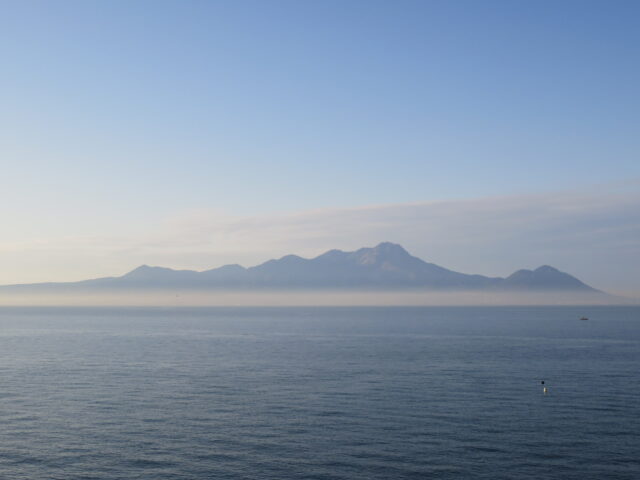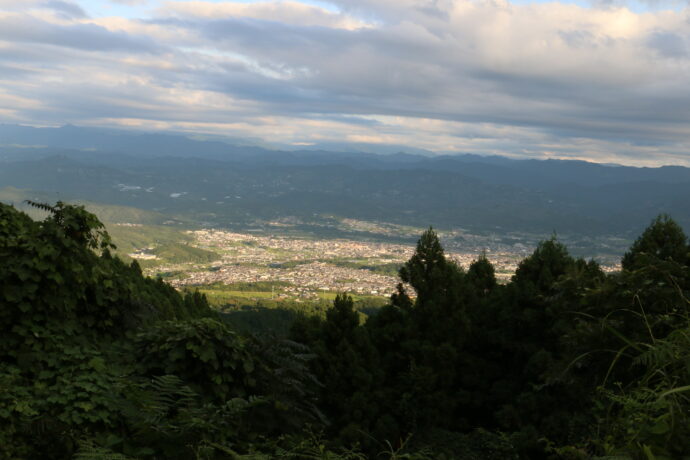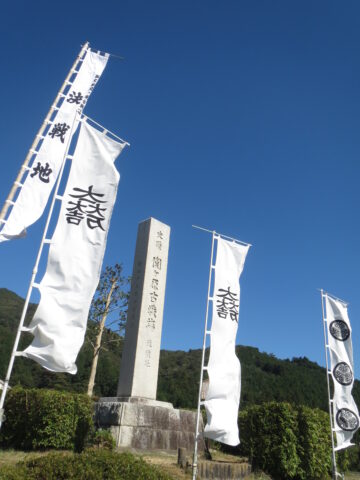2024.01.22
Commemorating the 400th Anniversary of Shimabara Castle Construction: The Story of Shigemasa Matsukura, the Lord of Shimabara Castle – I
The Castle of Kaido -The Biography of Shigemasa Matsukura
Yoshiyuki Amatsu

Shimabara Peninsula as seen from the Ariake Sea
-I-
It’s so blue!
Shigemasa Matsukura looked up at the sky, saying out loud, “It’s so blue.
The azure of the South Sea sky was so deep that it was almost blinding, and his eyelids narrowed at the unfamiliarity of it.
Shigemasa was born and raised in Yamato Province in the Kinai region. Surrounded by mountains, the sky in Yamato always looked hazy and the blue was pale and smoky.
Above all, there was nothing to block the sky. After all, this is the middle of the sea. Although there was land in the distance, there were no mountains so steep that they blocked half of the sky like Yamato’s. As the word “azure” implies, the sky looked up and down.
As the word “azure sky” implies, the sky above us was as deep as an arched shape, and the brightness of the open field of view in the upper sky was eye-opening. The brightness of the view from the upper sky was dazzling.
Shigemasa nodded his head without looking back. Approaching behind him was Shinbei Okamoto, a young but sturdy man who was trusted by Shigemasa as his trusted advisor.
Maybe it’s that thing called the sea.”
Shigemasa replied, but he did not look at the sea field that rocked the ship. As a mountainous country, Yamato has no sea. Not necessarily because of that, but it was certainly unfamiliar to him, and he was suspicious of the vastness and depth of the sea.
……Everything is different from Yamato.”
As he watched the land move away from the stern of the ship, this sentiment occupied Shigemasa’s mind. But it was not anxiety. It was merely the result of keeping his own excitement bottled up inside and focusing on what was right in front of him.
This feeling was similar to the one he had before the battle.
No, it seems there are similarities in Takamatsu.
Shinbei’s voice sounded somewhat amused as Shigemasa quietly faced his boiling heart. Looking back, he saw Shinbei walking toward the bow of the ship, hoping to see beyond the high sail.
Shigemasa wondered, followed his gaze, and then involuntarily rolled his eyes.
It was a huge mass blocking the sky. It was a wall-like mountain covered in deep green all over, with sharp peaks reaching for the sky. The ridges on either side of the mountain were deeply cut, and a faint smoke was rising from beyond them.
(Is it Mt.)
The majesty of the mountain reminded Shigemasa of the deep mountains of his hometown. As he looked at the stern but clear mountain, Shigemasa’s mouth was etched with a smile of confidence and hope.
Is that Onsensan*1?
The sailor who was working on a rope nearby looked up at him.
He looked up and saw a sailor who was working on a rope nearby.
Is there a name for each of these peaks?
The one in front is Maeyama*2, and there are others like Okuyama*3.
Maeyama. …… is an elegant sight.
Shigemasa muttered and headed for the bow with strong steps. Then he raised his haughty head as if to challenge the steep but graceful ridge of the mountain towering before him.
The more I looked at it, the more it resembled Mount Kongo overlooking Futami*4 in Yamato Province, his former domain.

View of present-day Gojo City, Nara Prefecture (Futami, Yamato Province)
Shigemasa Matsukura was born in Tensho 2 (1574) in Yamato Province.
His father was Shigenobu Matsukura Ukon-Oyu. He was a fierce general who served as aide-de-camp to Junkei Tsutsui, who had conquered the former capital of Heijo-kyo. Along with Kiyoki Shima Sakon, who later became famous for his bravery as aide-de-camp to Mitsunari Ishida, he was an important retainer known as “Ukon Sakon” of the Tsutsui clan.
The Tsutsui family eventually came to serve Toyotomi Hideyoshi, and in Tensho 11, Shigenobu was also given 3,000 koku of Ochi in Yamato Takaichi County. He became a direct vassal of Toyotomi while Junkei Tsutsui was his master.
In Tensho 13, when Junkei’s son Tsutsui Sadatsugu was transferred to Iga as a result of a change of province, his father Shigenobu followed his master to Iga and received 8,000 koku of governorship in Nabari.
(My talents can only be put to full use in a greater place, under the control of the sovereign.)
While the Tsutsui family was shaken by a dispute among vassals, Shigemasa, who had been given the governorship by his father, kept his distance from the entire Tsutsui family and worked to manage his territory as a direct vassal of Toyotomi. When Hideyoshi died, Shigemasa saw Tokugawa Ieyasu, the first of the Five Grand Elders, as the next great ruler of Japan, and approached him.
He participated in the conquest of Aizu Uesugi, which had raised an anti-Ieyasu banner, and when he heard the news of the uprising of Ishida Mitsunari, he quickly advanced to Mino as the spearhead and played an active role in the attack and defense of Takegahana Castle. In the Battle of Sekigahara, he joined Ii Naomasa’s forces and served in the front line.

Sekigahara ancient battlefield, the site of the decisive battle
This merit later saved Shigemasa’s life. In 1608, when the Tsutsui Disturbance led to the demolition of his family and the confiscation of his lands, Shigemasa was given 10,000 koku of Futami land in Yamato Province as a reward for his earlier military service.
Futami was a small place in a deep mountainous region, but it was a strategic point connecting Yamato and Kii, where the water transportation of the Kino River and numerous highways, including the Yoshino Kaido, intersected. Shigemasa, who was aware of the flow of people and goods coming and going there, established a new “Shinmachi” (new town) under the castle.
He protected commerce, reduced or exempted various government officials, and developed the town into an inn town that became the center of the southern Yamato region.
In addition, Shigemasa was a lion at the winter battle of Osaka in 1614. While many of the old vassals of the Tsutsui family joined the Toyotomi side, Shigemasa was one of the few to join the Tokugawa side.
He continued to fight to the end in the battle over Sanada-demaru, which was famous for Sanada’s warlike spirit, and even scolded Takatora Todo, the general of the Yoride, for his weak attitude.
In the summer campaign of the following year, Shigemasa became aware of the Toyotomi’s scheming in Iga and Yamato, and was quick to come to the rescue of Yamato Koriyama Castle, which was the starting point of the war.
Shigemasa’s activities were, of course, well received by Ieyasu.
To Katsunari Mizuno, who was to lead Shigemasa and other Yamato warriors in the summer campaign, Ieyasu said, “In the winter campaign last year, even though Takatora Todo was the leader of the Yamato-shu, there were some who did not obey his orders.
Ieyasu even encouraged him by saying, “If the generals of Yamatoguchi do not obey your orders, you may trample them down. In other words, he recognized Shigemasa’s ability.
His achievements in both military service and governance …… brought him to a new position, just as Shigemasa had hoped. He was transferred to Hinoe, Takaraigun, Hizen Province, with 40,000 koku.
This was the largest increase in the amount of money Shigemasa had ever received for his merits in the Battle of Osaka, excluding such feudal lords as Date and Maeda. In other words, Shigemasa’s skill was appreciated by the people of Japan.
In April of 1616, Shigemasa received a notice from Ieyasu in Edo that he was to be transferred to Hinoe, and on his way back to Yamato, he stopped at Ieyasu’s castle in Sunpu. He stopped at Ieyasu’s castle in Sunpu on his way back to Yamato to thank Ieyasu for the hospitality he had received.
Bungo is not a diligent man.
Ieyasu, who met Shigemasa on his sickbed, said of him. The courtesan who had stepped down from his position as barbarian general to become a grand courtesan was already seventy-five years old. His heavy, drooping eyes seemed to have become calm and withered in the face of death. Incidentally, Bungo is the common name for Shigemasa.
Is it at blistering ……?”
I am not. He is very diligent to live up to his reputation.
Although he was old, Shigemasa was indeed a man of the world, and he knew exactly what Shigemasa was really like.
He was once a member of the Toyotomi administration, and now he was a member of the Tokugawa shogunate. Shigemasa found it interesting to show his work within such a large framework and to fulfill his reputation.
His military exploits at Sekigahara and Osaka, as well as his rule of Yamato Futami, were all done to satisfy his sense of honor.
It is a great reward to be so recognized by His Highness.
Shigemasa was also aware of the fact that the court looked favorably on this sense of merit.
Shigemasa was aware that the downfall of the Iga Tsutsui family had been aimed at eliminating the foreign feudal lords who favored Toyotomi from the Kinai region. In addition, Ieyasu must have had a good reason why he had not been driven out of Yamato.
Looking at the result of the increase from 10,000 koku in Yamato Futami to 40,000 koku in Hizen Hinoe, it was clear that Shigemasa must have fulfilled this intention.
Shigemasa said, “Now that you have entrusted me with your domain, I will work diligently.
Hinoe had been ruled by the Arima clan for generations. However, his predecessor, Harunobu, was convicted of the so-called “Okamoto Daihachi Incident” involving the restoration of Arima’s former territory and trade with Macau, and was sentenced to be executed by beheading.
Naozumi, the son of Harunobu, was relieved of Hinoe without blame, partly because he was estranged from his father and partly because he had served close to Ieyasu and was well known to him.
However, Naozumi himself was not happy about it. He asked to be relocated to Nobeoka in Hyuga Province, and was allowed to do so two years ago. Hinoe was thus placed under the direct control of the Shogunate.
I don’t need to tell you.”
Shigemasa looked up at the casual tone of the conversation, and then changed his appearance. Ieyasu’s eyes were not smiling as he lay there looking at him.
The battle of the last year is still in progress,” he said. Do not forget that.
Less than a year had passed since the battle of Osaka, which destroyed Toyotomi. The warlords and ronin who had joined Toyotomi’s side had already been dealt with, but there were still many lords who had joined the Tokugawa side and were loyal to Toyotomi.
In the western part of the country, in particular, it was difficult to say that the Tokugawa shogunate, which had a stronghold in the Kanto region, was well controlled. What was the meaning of placing Shigemasa in the middle of this situation?
Ieyasu’s smile was again etched on Shigemasa’s face, as he understood Ieyasu’s unspoken intentions. This seemed to him to be a duty worthy of his own challenge.
Gyoi. I will see to it that you are satisfied with my work.
After leaving Sunpu, Shigemasa immediately returned to Gojo Futami and promptly prepared for the change of provinces. In June, news of Ieyasu’s death arrived, but Shigemasa obeyed the shogunate’s order not to offer condolences, and had his son Katsuie visit him.
In July, Ieyasu left Yamato-no-kuni, being missed by many of his people and seeing them off.
[notes]
1 Onsensan…present-day Unzendake
2 Maeyama: Present-day Bizan (Mt. Bizan)
3 Okuyama…present-day Fugendake
4 Futami, Yamato Province…present-day Gojo City, Nara Prefecture